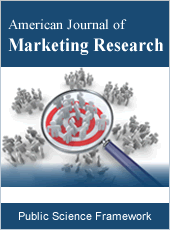American Journal of Marketing Research
Articles Information
American Journal of Marketing Research, Vol.1, No.2, Aug. 2015, Pub. Date: Jul. 23, 2015
Social Media, Traditional Media and Marketing Communication of Public Relations: A Study of Banking Industry
Pages: 79-87 Views: 5529 Downloads: 4100
[01]
Datis Khajeheian, Center for Communication, Media and Information Technology (CMI), Department of Electronic Systems, Aalborg University, Copenhagen Campus, Copenhagen, Denmark.
[02]
Fereshteh Mirahmadi, Department of Public Administration, Islamic Azad University, Tehran, Iran.
Public relations are undertaking more important role in the marketing communication and advertising. The present paper reports a survey conducted in three Iranian banks’ public relations departments to understand how they use different media in their marketing communications and other related functions. A classification of public relations functions including fourteen functions in three categories has taken as research framework and by using a questionnaire, eight media have been asked to rank for each function, includes Television, Radio, Newspaper, Magazine, Classified Ads, Internet Websites, Social media and finally Mobile and SMS ads. Findings show that traditional media still play a dominant role in media consumption of public relations, while new Web2.0 media consist of Mobile communications and Social networks, have never ranked better than fifth from eight. Some reasons have been argues in conclusion.
Public Relations, Social Media, Marketing Communication, Iranian Banking Industry
[01]
Adams, G.D. (1983), Museum Public Relations, American Association for State and Local History, Nashville, TN.
[02]
Avidar, R. (2013). The responsiveness pyramid: Embedding responsiveness and interactivity into public relations theory. Public Relations Review, 39(5), 440-450.
[03]
Berthon, Pierre R., Pitt, Leyland F., Plangger, Kirk, Shapiro, Daniel (2012). Marketing meets Web 2.0, social media, and creative consumers: Implications for international marketing strategy, Business Horizons 55, 261—271
[04]
Bruning, S. D., Dials, M., & Shirka, A. (2008). Using dialogue to build organization–public relationships, engage publics, and positively affect organizational outcomes. Public Relations Review 34(1), 25-31.
[05]
Curtis, Lindley, Edwards, Carrie, Fraser, Kristen L., Gudelsky Sheryl, Holmquist, Jenny, Thornton, Kristin, Sweetser, Kaye D. (2010), Adoption of social media for public relations by nonprofit organizations, Public Relations Review 36, 90–92
[06]
Cutlip, S.M., Center, A.H. and Broom, G.M. (1985), Effective Public Relations, 6th ed, Prentice-Hall, New Jersey, NJ.
[07]
Daymon, C., & Holloway, I. (2010). Qualitative research methods in public relations and marketing communications. Routledge.
[08]
DiStaso, M. W., McCorkindale, T., & Wright, D. K. (2011). How public relations executives perceive and measure the impact of social media in their organizations. Public Relations Review, 37(3), 325-328.
[09]
Gaither, T. K., & Al-Kandari, A. J. (2014). The cultural-economic model and public relations in the Middle East: an examination of the Islamic banking system in Kuwait. Public Relations Review, 40(1), 33-41.
[10]
Estanyol, Elisenda (2012). Marketing, public relations, and how Web 2.0 is changing their relationship: A qualitative assessment of PR consultancies operating in Spain, Public Relations Review 38, 831– 837
[11]
Eyrich, Nina, Padman, Monica L, Sweetser, Kaye D. (2008). PR practitioners’ use of social media tools and communication technology, Public Relations Review 34, pp 412–414.
[12]
Julien, Heidi (2008). Survey research In: Given, L. M. (Ed.). The Sage encyclopedia of qualitative research methods. Sage Publications.
[13]
Khajeheian, Datis, Farhangi, Ali Akbar, Hadavinia, Abbas (2010), Designing Media Management Interactive Model using modern information and communication technologies, Quarterly Journal of Communication research, Vol 16, No 4, in Persian
[14]
Khajeheian, Datis, Esmailkhou, Hamidreza, Yousefikhah, Sara (2012), Information technology and media convergence: An entrepreneurial approach towards media matrix management, African Journal of Business Management 6 (29) 8483-8489
[15]
Khang, H., Ki, E. J., & Ye, L. (2012). Social media research in advertising, communication, marketing, and public relations, 1997–2010. Journalism & Mass Communication Quarterly, 89(2), 279-298.
[16]
McKie, D., & Willis, P. (2012). Renegotiating the terms of engagement: Public relations, marketing, and contemporary challenges. Public Relations Review, 38(5), 846-852.
[17]
Miller, Gerald, J, Yang, Kaifeng (2008), Handbook of Research Methods in Public Administration, CRC press, Taylor & Francis Group.
[18]
Muk, A. (2012). Public relations functions: Perspective from a Japanese corporation. Public Relations Review, 38(1), 137-140.
[19]
Papasolomou, Ioanna, Kitchen, Philip J., Panopoulos, Anastasios (2013), The accelerative and integrative use of marketing public relations in Cyprus, Public Relations Review 39, 578– 580
[20]
Solis, B., & Breakenridge, D. K. (2009). Putting the public back in public relations: How social media is reinventing the aging business of PR. FT Press.
[21]
Steyn, Peter, Salehi-Sangari, Esmail, Pitt, Leyland, Parent, Michael, Berthon, Pierre (2010), The Social Media Release as a public relations tool: Intentions to use among B2B bloggers, Public Relations Review 36, 87–89
[22]
Strang, R.A. and Gutman, J. (1980), “Promotion policy making in the arts: a conceptual framework”, in Mokwa, M.P., Dawson, W.M. and Prieve, E.A. (Eds), Marketing the Arts, Praeger, New York, NY, pp. 225-39.
[23]
Weaver Lariscy, Ruthann, Johnson Avery, Elizabeth, Sweetser, Kaye D., Howes, Pauline (2009), An examination of the role of online social media in journalists’ source mix, Public Relations Review 35,pp 314–316.

ISSN Print: 2381-750X
ISSN Online: 2381-7518
Current Issue:
Vol. 7, Issue 3, September Submit a Manuscript Join Editorial Board Join Reviewer Team
ISSN Online: 2381-7518
Current Issue:
Vol. 7, Issue 3, September Submit a Manuscript Join Editorial Board Join Reviewer Team
| About This Journal |
| All Issues |
| Open Access |
| Indexing |
| Payment Information |
| Author Guidelines |
| Review Process |
| Publication Ethics |
| Editorial Board |
| Peer Reviewers |


